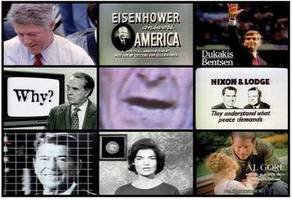Antoni Muntadas
dal 10/9/2010 al 8/10/2010
Segnalato da
10/9/2010
Antoni Muntadas
Galerie Gabrielle Maubrie, Paris
Political Advertisement (1952-2008)

"By running these spots back-to-back without commentary, Muntadas and Reesse allow their all-star cast (Eisenhower! Nixon! Ford! Reagan! Bush!) to dig their own graves (and ours) in primetime". San Francisco Cinemateque
With each presidential election since 1984, Antoni Muntadas and Marshall Reese have compiled a new edition of Political Advertisement, a historical survey of television campaign spots from 1952 to the present. This compelling anthology, updated to include advertisements from this year’s presidential campaign, charts of selling of the American presidency in the media age. Muntadas and Reese weave a revelatory social and media history that shows the ways in which campaign advertising has become political strategy and manipulative marketing technique. Muntadas’s works, extending from video to publishing to multimedia installations, have been internationally recognized for the biting examinations of the media as an instrument of socialization and normalization. Reese is a video artist and poet who, in addition to his collaborations with Muntadas, teams up with artist Nora Ligorano as the duo Ligorano/ Reese.
Muntadas and Reese decided to let the material speak for itself, without commentary.
"Political advertisement has changed", Muntadas notes. "At first ads gave information. With the evolution of advertising, ads give less information about the product, and they are more about strategy. What they want is to get people to buy the product – the candidate".
The spots of Political advertisement reveal just how much techniques have evolved from an Eisenhower trying to make his stances clear to his viewers to a Reagan playing to the dreams of his audience.
Political advertisement, like many of the other works of its editors, is a hybrid piece, blending European and the American perspectives. It is both a work of art and a piece of media criticism, even though the artists don’t claim to be media analysts. "We try to be objective as possible," says Muntadas. "Well, objectivity doesn’t exist. Yet, we try to keep some distance. There are choices to be made, and you have to build a discourse from these choices."
So, while the piece does not produce a theory of how political ads influence voters, it will inspire its viewers to look critically at both political advertising and politics. After being bombarded with political advertising for an hour, you are left with the impression that candidates are offered to consumers/voters in the same way that beers, fast food or candy bars are.
Today’s candidates are increasingly similar. They use the same gestures, the same metaphors, the same type of language, the same graphics, the same music in their campaign ads. The result is the continued erosion of public activities and public space as media consultants flatten political discourse and the polling station increasingly begins to resemble the checkout aisle at the grocery store.
Galerie Gabrielle Maubrie
24, rue Sainte-Croix de la Bretonnerie 75004 Paris
The gallery is opened from tuesday through saturday from 2 to 7pm followed by another exhibit of Muntadas 'Fear' opens October 9





